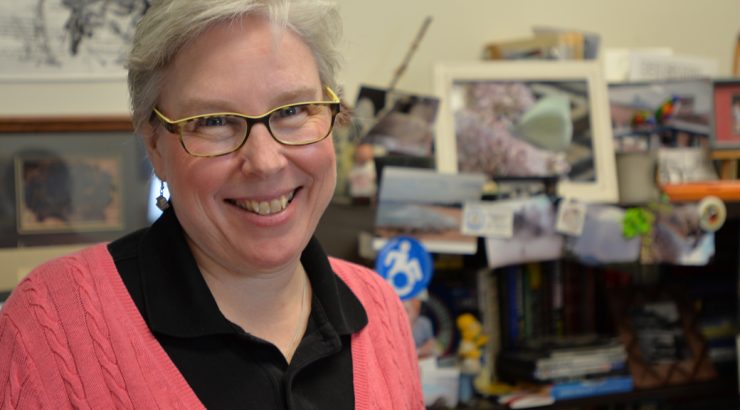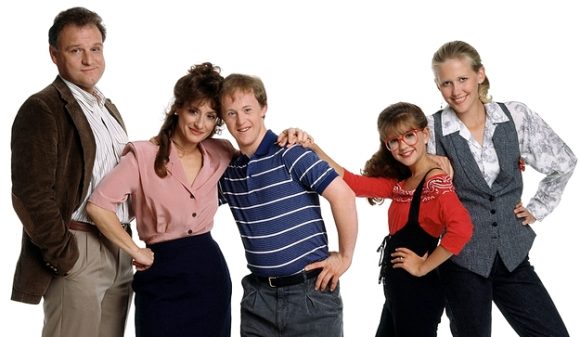
A Wish for Authentic Disability Representation on Television to Continue By Beth Haller, Ph.D.
July 14, 2017
We are in vibrant “new” world of authentic disability representation on television, with shows like Switched at Birth, Speechless, Little People, Big World, and Born This Way. However, is this authentic representation so new? In the 1980s, several scholars evaluated authentic disability representation on television when disabled actors appeared on screen, looking at their impact on audiences. Blind actor Tom Sullivan guest starred on a number of TV shows from the 1970s through the 1990s, and researchers Tim Elliott and Keith Byrd ran an experiment to study the audience response to Sullivan’s non-stereotypical presentation of blindness in the hit show Mork and Mindy (1978-1982). In addition to viewing the episode, the researchers discussed misconceptions and stereotypes about blindness with participants. Elliott and Byrd found that the viewing and discussion of stereotypes created a nonthreatening environment for participants, allowing them to shift their misconceptions and to accept accurate information about disability.
Research in the 1990s about the first TV show to feature an actor with Down syndrome, Life Goes On (1989-1993), had similar findings. An experimental study in 1999 looked at both a documentary with an independent person with Down syndrome and the Corky character with Down syndrome from Life Goes On. The research participants saw active, socially engaged people with Down syndrome and that helped counter negative stereotypes of people with disabilities. Most importantly, the participants began to see people with Down syndrome as having equal status in society.

This research illustrated several decades ago that media representations of disability have the power to change audience beliefs about disability. So why does authentic disability representation on TV ebb and flow so significantly? I believe the answer has three parts.
1. News coverage of disability rights at the time.
2. The shift from guest starring roles to principal character roles.
3. The birth of reality TV.
First, TV writers do not write in a vacuum. They may be writing a 1970s show about a medical unit during the Korean war (M*A*S*H, which ran from 1972 to 1983), but before they head off to the writers’ room at a TV studio in Los Angeles, they might see news stories about the 1977 disability rights protests at the San Francisco office of the U.S. Department of Health, Education and Welfare. Obviously, I cannot prove an explicit connection, but my point is that news media coverage of disability topics reminds everyone, including TV writers, that people with disabilities exist. In addition, once disability is in the mix for a plotline, other connections pop up. In the case of the TV show M*A*S*H, the blind actor Tom Sullivan appeared in an episode in 1976, the late actor William Christopher, who played Father Mulcahy, had an autistic son, and actor Gary Burghoff, who played Radar, has a disabled left hand from birth.
Secondly, disabled actors working in the 1970s and 1980s who were able to get recurring roles or star as main characters on TV shows reinforced for producers that a disabled actor could carry a show. Deaf actor Linda Bove appeared on Sesame Street from 1972 to 2002, which is the longest recurring role in TV history for a Deaf or disabled person. Actor Geri Jewell, who was on Facts of Life from 1980 to 1984, became the first person with a disability to have a recurring role on primetime TV. In addition, when Chris Burke starred in Life Goes On, he proved that an actor with Down syndrome could carry a prime-time television show.
I see a direct line from Linda Bove, Geri Jewell, and Chris Burke to actor Micah Fowler, a wheelchair-using actor with cerebral palsy who currently stars in the ABC prime-time comedy Speechless. With the same kind of trajectory, it is my hope that Speechless will lead to more disabled actors being hired in the next few decades. As Lawrence Carter-Long, formerly of the National Council on Disability, wrote in 2016, “Speechless matters because inclusivity on TV promotes inclusivity in life.”
Finally, as much as everyone likes to complain about reality TV, it put actual people with disabilities in front of the cameras to show audiences their lives. Also, when their shows became a hit, it gave disabled people more control of the reality shows that featured them.
One of the first versions of the modern reality show, The Real World on MTV, featured in 1992 an actual person with an HIV/AIDS diagnosis, Pedro Zamora. President Bill Clinton credited Pedro Zamora with helping lessen the fear people had of those with HIV/AIDS.
Little People Big World (LPBW), which chronicled the lives of the Roloff family in Oregon, premiered on TLC in 2006. The parents, Amy and Matt, both have dwarfism, as does one of their four children. Amy Roloff said in 2010 that when they were approached about doing the show, they saw it as a good way to educate the general public about dwarfism. “Nothing had depicted dwarfism in an everyday way,” she said. LPBW ushered in a number of reality shows about little people. Although mostly viewed as positive, some have criticized these shows as playing into TV audiences’ voyeurism about people with dwarfism.
The success of the show led to more than just reality shows about little people. Little People Big World’s producer also created Push Girls for the Sundance channel, a 2012-2013 reality show about four Los Angeles women who are wheelchair users. These reality shows had good ratings and proved to TV executives that TV audiences are interested in lives of people with disabilities, whether they have a connection to disability or not.

Personally, I have had several conversations about these shows with people who are not connected to the disability community, but they told me they were avid watchers of Little People Big World and Push Girls. (A few years ago, a student of mine, who is a soccer player, said she liked LPBW because the show featured lots of soccer when the Roloff children were still in high school.)
These reality shows are the ancestor of the hugely successful current reality show Born This Way on A&E (2015-present), which features adults with Down syndrome gaining independence and navigating friendships, employment and romantic relationships. During its first season, it increased its ratings by 85%, which was the highest rating increase in A&E’s history. The show also won an Emmy for Best Unstructured Reality Series in 2016. Born This Way executive producer Jonathan Murray said in 2016 that television is no longer a vast wasteland but a place for enlightenment for audiences on a many aspects of life, including disabled people’s lives. “For too long, people with disabilities, including Down syndrome, have been placed on the sidelines of life and the margins of primetime.”
Murray, who was a producer on MTV’s The Real World, says Born This Way is more real and authentic, and the production team could not use the typical reality show “tricks” to create drama. “We sort of knew we had something very genuine and very authentic … had to go back to that and trusting the emotion of the scene and that the emotional connection viewers would have with the seven adults would carry through to commercial, and that’s very different,” Murray told Deadline in 2016.
Good television begets more good television, so it is my hope that the ebb and flow of authentic disability representation is over, and the stories of actual disabled people, with authentic casting and plotlines, will become a permanent part of the television landscape.
References
Angelo, M. (2012, June 1). They are Pretty, Normal, and in Wheelchairs. The NY Times. http://www.nytimes.com/2012/06/03/arts/television/push-girls-on-sundance-looks-at-disabled-women.html
Carter-Long, L. (2016, October 3). How ABC’s Speechless is changing attitudes about disability. Upworthy. http://www.upworthy.com/how-abcs-speechless-is-changing-attitudes-about-disability
Cooper, C. (2010). The Big World of Amy Roloff. Ability Magazine. http://www.abilitymagazine.com/amy-roloff.html
De Moraes, L. (2016, Sept. 26). Born This Way Celebrates Emmy Win with Third-Season Pickup From A&E. Deadline.com. http://deadline.com/2016/09/born-this-way-celebrates-emmy-win-third-season-pickup-1201819392/
Elliott, T. R. & Byrd, E.K. (1984). Video Depictions of Blindness and Attitudes toward Disability. Journal of Rehabilitation. Jan-Mar84, Vol. 50 Issue 1.
Emmys.com. (2016, June 10). Born This Way Receives a 2016 Television Academy Honors Award
http://www.emmys.com/video/born-way-receives-2016-television-academy-honors-award
Hall, H. & Minnes, P. (1999). Attitudes toward Persons with Down syndrome: The Impact of Television, Journal of Developmental and Physical Disabilities, Vol. 11, No. 1.
Internet Movie Database. (2017). http://www.imdb.com/?ref_=nv_home
Kennedy, D. (2006, March). Little People, Big World. Will TLC’s new reality show change our perception of dwarfs? Slate. http://www.slate.com/articles/arts/culturebox/2006/03/little_people_big_world.html
About the author:
Beth Haller, Ph.D. is one of the first mass communication scholars to study the representation of disability is mass media. Haller is the author of 2010’s Representing Disability in an Ableist World: Essays on Mass Media and the editor of 2015’s Byline of Hope: Collected Newspaper and Magazine Writing of Helen Keller. She is the former co-editor of the Society for Disability Studies’ scholarly journal, Disability Studies Quarterly, (2003-2006). She currently maintains a blog on disability issues in the news, Media dis&dat, http://media-dis-n-dat.blogspot.com/’, as well as a website on media and disability research at www.media-disability.net. She has been researching news and entertainment media images of disability since 1991. Her research has been published in Disability Studies Quarterly, Canadian Journal of Disability Studies, Disability & Society, Review of Disability Studies, Journalism Studies, Journal of Popular Film and Television, Research in Social Science and Disability, Journal of Comic Art, Journal of Magazine and New Media Research, Mass Comm Review, and Journalism History. She is Professor of Journalism and New Media in the Department of Mass Communication & Communication Studies at Towson University in Maryland, where she has been a full-time faculty member since 1996. She is adjunct faculty for the City University of New York’s (CUNY) Disability Studies master’s and undergraduate programs and for York University’s Critical Disability Studies graduate program in Toronto, Canada.
